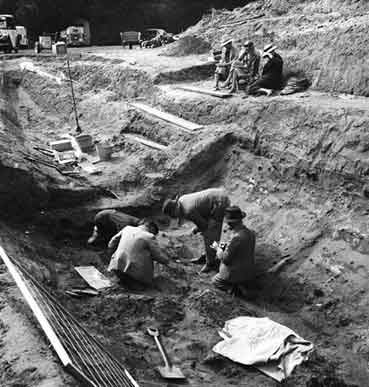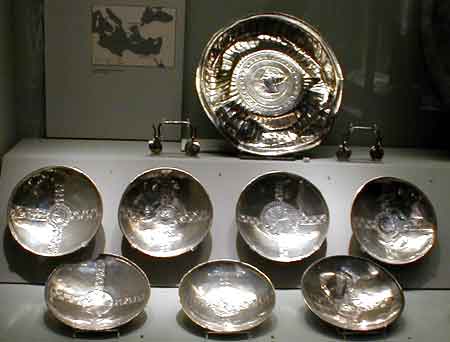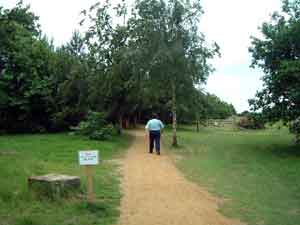In the 7th century AD, a King – it was surely no less – received a magnificent burial at Sutton Hoo, in East Anglia. A ship was hauled up from the river, a burial chamber was erected in the middle of it, and a stupendous collection of magnificent objects – gold and silver brooches and dishes, the sword of state, drinking horns and a lyre – was set in the burial chamber.

Fortunately, grave robbers never discovered the tomb, until in 1939 archaeologists stumbled upon what is still the greatest ‘treasure’ ever discovered in this country.

In 2002 was acquired by the National Trust, and a new Visitor Centre was opened, and the site was made available to the public.
The magnificent treasure in the British Museum
The Sutton Hoo burial forms one of the greatest treasures of the British Museum. Here we see a few of the most spectacular objects were found in the burial chamber that had been constructed at the centre of the ship.

The helmet has become a symbol of the Sutton Hoo burial; yet it survived as a mass of small pieces, and was only reconstructed after years of painstaking work in the British Museum Laboratory.
Photo: British Museum
At the centre of the chamber was presumably the body – though as the soil was so acid, it had not survived. Around the body were the most personal treasures. Bellow is the great ‘purse lid’ with elaborate gold decorations on the outside. The purse was probably attached to a wide leather belt by the three hinges at the top and fastened by the sliding catch at the bottom. The purse contained 37 gold coins, dated to around AD 625. Left. One of the buckles that fastened the king’s belt, made of gold, inlaid with red garnets


The burial was accompanied by numerous exotic items – this set of silver bowls come from the Byzantine world.

This hanging bowl, by contrast, is commonly considered to be ‘Celtic’. The red roundels are decorated with Celtic swirls, typical of Celtic art from the Iron Age.

Some of the weapons buried with the dead man


Left. This ring, surmounted by a stag, is thought to have been set at the top of a whetstone: the whole is generally interpreted as a sceptre, an emblem of royal authority.
Right. The great shield, found up against the wall of the burial chamber. The actual shield seen here is a reconstruction; however the central boss, and the various strips of metal that decorated the shield, are the originals.
These are but a few of the treasures to be seen in the British Museum
Cemetery
The excavations in 1939 revealed a magnificent ship burial. However the excavations took place under the shadow of war, and had to be hurriedly concluded. However the great barrow that covered the ship did not stand alone.was merely the largest mound in a cemetery of 19 mounds and numerous other burials, and in the 1980s, a new excavation was launched to reveal the rest of the cemetery.
Martin Carver, who directed the excavation on behalf of the British Museum and the Society of Antiquaries, presented his work as a drama in Three Acts in which we see the grand Twilight of the Gods of the pagan Saxons in face of the rising tide of Christianity that was to overwhelm them.
Aerial View 
The excavations lie at the centre of this panoramic view. The Ship burial mound is below and to the left – between the excavations and the excavators’ compound.
In the distance, at the top, is the River Deben, with the town of Woodbridge beyond it.
Burial of horse and rider
The most spectacular of the recent discoveries was this double burial under a single mound, of a young man in the pit to the left, and his horse in the right hand grave. Some of the grave goods can be seen to the right of the young man, first a bucket, then a bronze cauldron with a pot inside it beneath. At the top of the coffin is the horse harness.

The excavator sees this as being the beginning of the cemetery – Act 1 of the drama. This is indeed a very high caste grave, – but it is not a royal grave. This rich burial, though unusual, would not be out of place in a folk cemetery. But the cemetery is beginning to become a high status cemetery.
The ship that was buried was presumably hauled up the steep slope from the river
Plan of Sutton Hoo 
The two ship burials are marked by ship signs. The great burial is centre left, the smaller ship burial -see below – is at the top.
These graves mark Act II of the drama. Christianity was beginning to make itself felt, and the pagans, under pressure, responded by indulging in ever more elaborate ritual. Cremation was adopted, in defiance of Christianity: two burials were in bronze bowls, one was placed on an oak tray.
Most sinister of all, there is a hint of human sacrifice. Mound 5, just below the the ship burial mound 2, has several burials – inhumations – surrounding a central cremation. Most enigmatic of all is the small group of graves to the right, many of them buried in distorted positions. Were they sacrifices round a central tree?
The ship Burials

In the final phase – Act III – the most extravagant burial method of all was adopted – ship burial. There were two ship burials at Sutton Hoo – the great ship burial excavated in 1939, and the smaller one in mound 2, excavated in 1938 and here being re-excavated in 1985.
Instead of the ship being buried first and a chamber built inside it, here the chamber was built first, and the ship was then placed on top of it. Here we see the rectangular chamber at the bottom, with the outline of the ship above it. Unfortunately it had already been robbed, probably in 1860, but the excavators were still able to find a few fragments from which they were able to suggest the position of the body, and that it was accompanied by a sword, a shield, drinking horns, and a cauldron and cauldron chain.
The mound has now been reconstructed and forms the most prominent feature on the site.
The final Scene – Act III, Scene 2 – was the great ship burial, excavated in 1939 – but for this you will have to go and see the actual treasures, now in the British Museum! After that, the curtain falls. Christianity triumphs, and the cemetery is abandoned. Paganism suffers the fate of the losers: it is derided, disparaged – and forgotten.
This is based on a fuller account in Current Archaeology 128.
Visiting Sutton Hoo
For long, Sutton Hoo was in private hands, but in 1998 it was given to the National Trust. A Visitor Centre has been opened, and visitors are now welcome. It is situated off the B10832 road, two miles east of Woodbridge [TM288487]. Here is a short guide to what you may see on your visit.
Click here for the official National Trust web site, with the opening hours.
(Note there is a charge for entering the car park. Opening hours are restricted: it closes at 5 in the summer, and is only open at weekends in the winter. However it is, (I believe) possible to walk round the site even when the Visitor Centre is closed).
Click here for the web pages of the Sutton Hoo society who occasionally conduct excellent guided tours of the site.
Approaching the visitor Centre

The Visitor Centre (which is the dark building on the left) is set in the courtyard of the former stables of Tranmer House
The Visitor Centre

The Centre consists of two buildings, the Exhibition Hall (right) and the shop and cafe (left)

It is a long walk from the Visitor Centre to the Burial Ground – it is said to be only 500 metres, but it feels more like half a mile.

On your right, notice Tranmer House. This is where Mrs Pretty lived, who sponsored the original excavations in 1939, and then gave the treasure to the British Museum. It is now an Educational Centre

Then on your left, notice the glimpses of the River Deben, and imagine what it must have been like to haul a ship up from the river to the burial place.
Eventually the cemetery appear, in the form of Mound 2.

It must be said, it is a little misleading in that Mound 2 is the only mound to have been ‘restored’ in the course of the recent excavations. It has been restored more or less to its original height, but since none of the other mounds have been restored, mound 2 dominates the whole cemetery.
Mound 2 was never as big, or as important, as Mound 1. It was nevertheless probably the second most important mound, for it too contained a ship burial (probably) though unlike Mound 1, it had been robbed, and therefore no trace remained of the original burial.

The visitors are not allowed to go in among the mounds, but have to keep to the path and walk around the outside.
At first the mounds are barely visible, but gradually the outline of the low mounds become clear

Note the field on the other side of the pathway.
It has a most unusual crop – turf!
Every year it is sown to grass, the grass is mown and made into beautiful turf, which is them lifted and taken off to some lucky garden somewhere.
When the turf is growing it is a lovely grassy sight; after it has been harvested, the field is just bare earth.
The ship mound itself is, after all this, a little disappointing. There is a viewing platform from which it can be viewed – just so you know where it was. The ends of the ship are marked out by two thin posts – one of them can just be seen slightly left of centre. But this is where the greatest treasure ever discovered in Britain, was once buried.

The Excavations under the Visitor Centre
What was Sutton Hoo like, before the great ship burial? When the National Trust was given Sutton Hoo, they set about building a Visitor Centre. This meant that they had to carry out excavations under the Visitor Centre – presuming there would be nothing there. To their surprise, the excavations revealed a second, smaller and hitherto unknown Saxon cemetery

Excavations in progress
Excavations in progress under the proposed new Visitor Centre.

The most important grave was that of a warrior. He was buried covered by his shield, and these fierce images decorated his shield. The top image possibly represents a sea creature with his jaws to the right, the bottom one perhaps a bird of prey with a snake in his claws.

There were not only burials (inhumations) in the cemetery, but also cremations. One of the cremations was in the splendid bronze hanging bowl, with ‘Celtic’ style decorations

In 1986, a local farmer, harrowing a field at Bromeswell, not far from the cemetery found three pieces of a shallow bronze bucket about the size of a casserole dish. There was an inscription around the top: “Use this in good health, Master Count, for many happy years”. When the bowl was cleaned, they discovered a frieze of hunters, seen right. The bucket was probably made in a workshp in Antioch during the 6th century AD, and eventually made its way to the Anglo-Saxon world.


Want to know more about the incredible discoveries taking place right now across Britain? Subscribe to Current Archaeology magazine, and we’ll send the details straight to your door every month! Get all the latest archaeological news, and read about the fascinating sites that are constantly being unearthed. With the photographs accompanying the features, you’ll feel like you’ve seen it for yourself!
Don’t miss out: click here to find out more about subscribing today.




Decades ago I read a book on Sutton Hoo. I had no idea there had been further excavations. Fascinating. Congratulations on setting up a visitors centre.
Absolutely brilliant web site – it sets the excavated burials and the mounds in the context of the overall landscape. Fantstic display for all ages interested in archaeology.
Very good description and very interesting.
It’s odd that the author of this interesting synopsis didn’t tell the readers what language the inscription was in:
“There was an inscription around the top: “Use this in good health, Master Count, for many happy years”.
Good call, Joseph! It’s in Greek.
I am studying it at school!!!:)
Really interesting website and good pictures, I am making a copy of the helmet for a project at school.
This is the best website ever
[…] http://www.archaeology.co.uk/specials/the-timeline-of-britain/sutton-hoo.htm […]
[…] http://www.archaeology.co.uk/specials/the-timeline-of-britain/sutton-hoo.htm […]
My family comes from Woodbridge and Bromeswell and I have happy memories of running around the fields at sutton hoo when I was a young boy, I even gave a speech at woodbridge school( I was a boarder) to all the school about sutton hoo in about 1952!!!!! I have 2 questions,
1.was the person buried a “warrior”? 2.did he die in battle? If so, where was the battle?Or did he die from natural courses?
Christopher Green
Good Morning,
I enjoy your informative site…fantastic…and actual photos of location that we hope to visit on our next trip to England!
Maybe you can help me…I am looking for a photo of the Sutton Hoo Helmet, in a high resolution, to show the detail of it; would you perhaps have any suggestions? The museum maybe?
Hi Nancy,
You can see other images of the helmet on the British Museum’s website – http://www.britishmuseum.org/research/collection_online/collection_object_details.aspx?assetId=35172001&objectId=86159&partId=1
Best wishes,
The CA Team
This really helped me in my school report. Thanks a lot!
hi this helped me in school 6th grades hard
Does anyone know who the author of this article is?